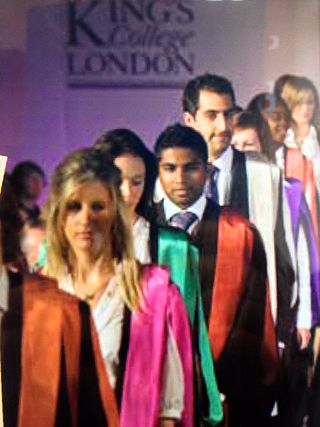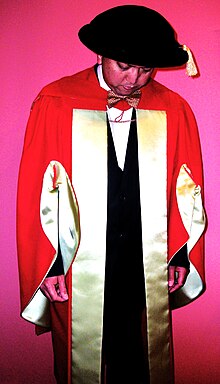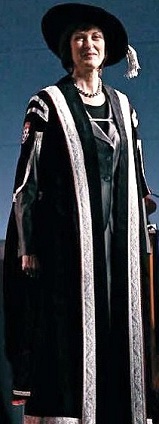
Academic dress is a traditional form of clothing for academic settings, mainly tertiary education, worn mainly by those who have obtained a university degree, or hold a status that entitles them to assume them. It is also known as academical dress, academicals, and, in the United States, as academic regalia.

The University of Oxford has a long tradition of academic dress, which continues to the present day.

The academic dress of Durham University has many similarities with that of other older British universities such as Oxford and Cambridge. Most colleges of Durham University insist on gowns being worn on formal occasions, including matriculation and formal halls (dinners); exceptions are Van Mildert, St Cuthbert's Society, Collingwood, Stephenson, St Aidans, and The College of St Hild and St Bede. Some colleges also insist on their being worn to Junior Common Room meetings, and they are often seen in college chapels. At formal halls, only gowns are worn and doctors normally wear their undress gowns; for more ceremonial occasions full-dress gowns and hoods are worn by graduates. Until 1990, the General Regulations of university 'recommended' the wearing of gowns by members of the university when attending divine service at the Cathedral – but this is now left to individual choice apart from at certain services. Gowns are also customarily worn to meetings of the university Senate by members of that body.
The academic dress of the former University of Wales was designed for the first graduations in 1893, and has as its main identifying feature a faculty colour scheme involving 'shot silks'.

The University of Cambridge has a long tradition of academic dress, which it traditionally refers to as academical dress. Almost every degree which is awarded by the University has its own distinct gown in addition to having its own hood. Undergraduates wear college gowns, which are all subtly different; these differences enable the wearer's college to be determined. Academic dress is worn quite often in Cambridge on formal, and sometimes informal, occasions, and there are a number of rules and customs governing when and how it is worn. Black gowns (undress) are worn at less formal events, while on special occasions full academical dress is worn, consisting of gown, hood and headdress with Doctors in festal dress. The University's officials also have ancient forms of academic dress, unique to the University.
The academic dress prescribed by the University of Bristol is a mixture of that prescribed by Cambridge and Oxford. Bristol has chosen, for graduates, to mainly specify Oxford-style gowns and Cambridge-style hoods. Unlike many British universities, the hood itself is to be "University red", lined with a specified colour. University red is defined to be Pantone 187. Bristol also specifies that undergraduates are to wear gowns "of the approved pattern" in certain circumstances, although the pattern itself is not specified. This is not too important since, in practice, undergraduates are only required to be gowned when graduating or at dinner as a member of Wills Hall.
The academic and official dress of the University of Warwick dates originally from the mid-1960s, shortly after the university's foundation. Despite persistent offers from Charles Franklyn the theatrical costume designer Anthony Powell was commissioned to design robes for officials and graduates of the university. Due to pressure of other work, and some apparent differences of opinion, Powell withdrew from the project, and the robes for graduates subsequently designed in consultation with J. Wippell and Company of Exeter, with Ede and Ravenscroft designing and making the robes for officials.

The academic dress of the University of Melbourne refers to the formal attire, including robes, gowns, and hoods, as prescribed by the Statutes and Regulations for undergraduates, graduates, officers, and honorands of the university. This follows the style of the University of Oxford for the gowns and hoods for Bachelors and Masters degrees. Melbourne adopts the style of the University of Cambridge for its doctorates. The hoods are all black, resembling the size and shape of the Oxford MA hoods, which are in the simple Burgon shape. These hoods are lined with the color specified for the corresponding faculty or degree and are bound with white on the lower edge for bachelors, while masters' hoods have no binding. The specific faculty or degree colors are outlined in the University Regulations. In the past, Pass degrees were bound in fur and Honours degrees in silk; however, this distinction no longer holds. Bachelors wear an Oxford Bachelors gown, while Masters wear an Oxford Masters gown. The gown for undergraduate students is the same as the bachelors', but its sleeves must not be split.
Academic dress of the University of London describes the robes, gowns and hoods which are prescribed by the university for its graduates and undergraduates.

As the oldest college in the United States, Harvard University has a long tradition of academic dress. Harvard gown facings bear crow's-feet emblems near the yoke, a symbol unique to Harvard, made from flat braid in colours distinctive of the wearer's qualification or degree. Crow's-feet are double for earned degrees, and triple for honorary degrees.
There are a number of universities in Queensland, Australia, all with distinct academic dress.
The academic dress of the University of Kent is normally only worn at graduation ceremonies. In common with most British universities a graduand begins the ceremony wearing the dress of the degree to which they are being admitted. This is in contrast to the practice at some universities such as Oxford where a graduand only dons the dress of a degree after it has been conferred.
This page describes the different types of academic dress allowed at the University of Exeter. Definitions of the academic dress for the award holders and officials of the university are set out in the university's regulations.
The University of Leeds, like other universities in the United Kingdom and many other countries throughout the world, has its own unique system of academic and ceremonial dress for undergraduates, graduates and senior officials. As at most other universities, graduands will wear the gown, hood and hat appropriate to the degree they are about to receive. All of the graduates' hoods incorporate one or more shades of green, and the Doctors of Philosophy, Education and Clinical Psychology are unique in the UK in having a green full-dress gown.

Academic dress of the University of Manchester describes the gowns, hoods and headwear which are prescribed by the university for its graduates and officers.

The academic dress of the United Kingdom and Ireland has a long history and has influenced the academic dress of America and beyond. The academic square cap was invented in the UK as well as the hood which developed from the lay dress of the medieval period.

Academic dress has a history in the United States going back to the colonial colleges era. It has been most influenced by the academic dress traditions of Europe. There is an Inter-Collegiate Code that sets out a detailed uniform scheme of academic regalia that is voluntarily followed by many, though not all institutions entirely adhere to it.
The academic dress of Liverpool John Moores University is the formal attire worn by academics and graduating students at the university on formal occasions. This includes graduation and inauguration ceremonies of senior academic officers where it is compulsory to be worn. The regalia has been used since the institute was granted university status in 1992 were Ede & Ravenscroft was appointed the official tailor for academic dress.
The academic dress of the Robert Gordon University is normally only worn at graduation ceremonies and occasionally at other very formal events. In common with most British universities, a graduand of the Robert Gordon University begins the ceremony wearing the dress of the degree to which they are being admitted except for the hood. This is in contrast to the practice at some universities such as Oxford where a graduand only dons the dress of a degree after it has been conferred. The current pattern of academic dress dates from 1992 when the institution became a university.
The current academic dress of the National University of Ireland was simplified following a review in 1999. The design of the gowns generally follows that of Oxford. The hoods are primarily green, representing Ireland, and generally follow the design of Dublin or Belfast.
















